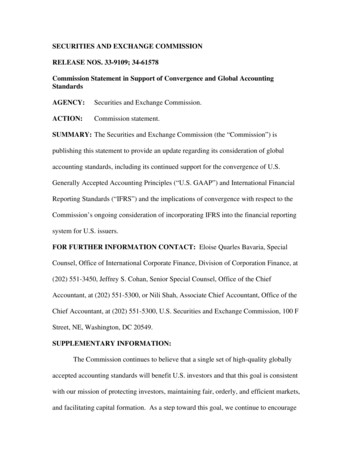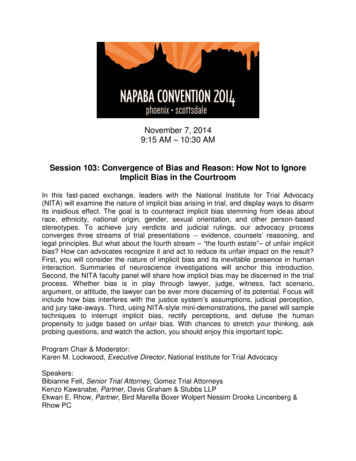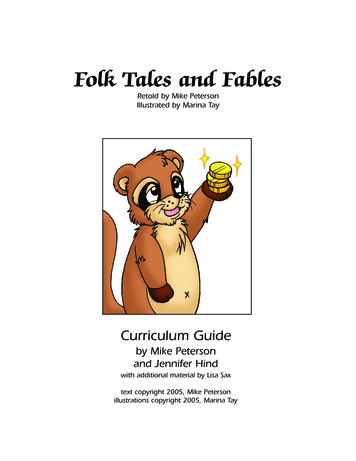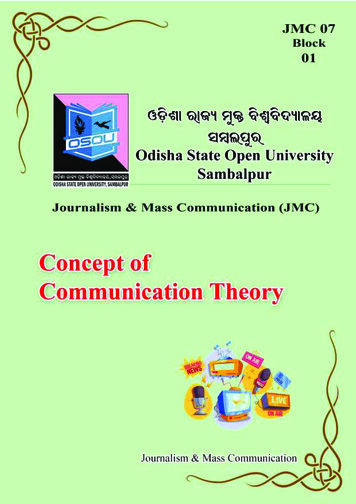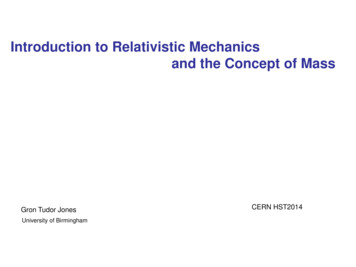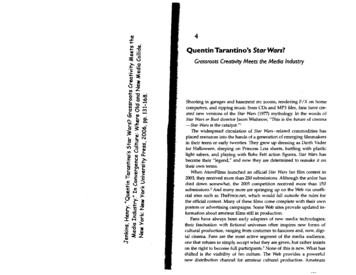
Transcription
4Q).&:.0wQ)Quentin Tarantino's Star Wars?. "'CQ) Q)- Grassroots Creativrty Meets the Media Industry o2'. - "'CQ). B L.Q)\Jzwo s:"""'Coo-0fa."'C,V)V)-.aO L.CJ)Q)C".Q)L. .&:. Q.Q. a -O Q)gL. NL.C:S::l.V')V)-0Vi::IQ)Q)Q.Q)'--V)\Jg. s:0\c:sL.L.L. V)L.Q)a " ' or- s: s:s: 0 ::: a\L::. :\J.xs: s:Q)HL.0 - Q)::111?o zs: "'C .Q)s:.::J:.::I:H5a w .s:'-"'CQ) Q),., ZQ) .Shooting in garages and basement rec rooms, rendering FIX on homecomputers, and ripping music from CDs and MP3 files, fans have created new versions of the Star Wars (1977) mythology. In the words ofStar Wars or Bust director Jason Wishnow, 'This is the future of cinema-Star Wars is the catalyst."]The widespread circulation of Star Wars-related commodities hasplaced resources into the hands of a generation of emerging filmmakersin their teens or early twenties. They grew up dressing as Darth Vaderfor Halloween, sleeping on Princess Leia sheets, battling with plasticlight sabers, and playing with Boba Fett action figures. Star Wars hasbecome their "legend," and now they are determined to remake it ontheir own terms.When AtomFilms launched an official Star Wars fan film contest in2003, they received more than 250 submissions. Although the ardor hasdied down somewhat, the 2005 competition received more than 150submissions. 2 And many more are springing up on the Web via unoffi7cial sites such as TheForce.net, which would fall outside the rules" forthe official contest. Many of these films come complete with their ownposters or advertising campaigns. Some Web sites provide updated information about amateur films still in production.Fans have always been early adapters of new media technologies;their fascination with fictional universes often inspires new forms ofcultural production, ranging from costumes to fanzines and, now, digital cinema. Fans are the most active segment of the media audience,one that refuses to simply accept what they are given, but rather insistson the right to become full participants.3 None of this is new. What hasshifted is the visibility of fan culture. The Web provides a powerfulnew distribution channel for amateur cultural production. Amateurs
Quentin Tarantino's Star Wars?have been making home movies for decades; these movies are goingpublic.When Amazon introduced DVDs of George Lucas in Love (1999), perhaps the best known of the Star Wars parodies, it outsold the DVD ofStar Wars Episode I: The Phantom Menace (1999) in its opening week. 4 Fanfilmmakers, with some legitimacy, see their works as "calling cards"that may help them break into the commercial industry. In spring 1998,a two-page color spread in Entertainment Weekly profiled aspiring digital filmmaker Kevin Rubio, whose ten-minute, 1,200 film, Troops(1998), had attracted the interests of Hollywood insiders. s Troops spoofsStar Wars by offering a Cops-like profile of the stormtroopers who dothe day-in, day-out work of policing Tatooine, settling domestic disputes, rounding up space hustlers, and trying to crush the Jedi Knights.As a result, the story reported, Rubio was fielding offers from severalstudios interested in financing his next project. Lucas admired the filmso much that he gave Rubio a job writing for the Star Wars comicbooks. Rubio surfaced again in 2004 as a writer and producer for DuelMasters (2004), a little-known series on the Cartoon Network.Fan digital film is to cinema what the punk DYI culture was tomusic. There, grassroots experimentation generated new sounds, newartists, new techniques, and new relations to consumers which havebeen pulled more and more into mainstream practice. Here, fan filmmakers are starting to make their way into the mainstream industry,and we are starting to see ideas-such as the use of game engines asanimation tools-bubbling up from the amateurs and making theirway into commercial media.If, as some have argued, the emergence of modem mass mediaspelled the doom for the vital folk culture traditions that thrived innineteenth-century America, the current moment of media change isreaffirming the right of everyday people to actively contribute to theirculture. Like the older folk culture of quilting bees and bam dances,this new vernacular culture encourages broad participation, grassrootscreativity, and a bartering or gift economy. This is what happens whenconsumers take media into their own hands. Of course, this may bealtogether the wrong way to talk about it-since in a folk culture, thereis no clear division between producers and consumers. Within convergence culture, everyone's a participant-although participants mayhave different degrees of status and influence.Quentin Tarantino's Star Wars?It may be useful to draw a distinction between interactivity andparticipation, words that are often used interchangeably but which, inthis book, assume rather different meanings. 6 Interactivity refers to theways that new technologies have been designed to be more responsiveto consumer feedback. One can imagine differing degrees of interactivity enabled by different communication technologies, ranging from television, which allows us only to change the channel, to video gamesthat can allow consumers to act upon the represented world. Such relationships are of course not fixed: the introduction of TiVo can fundamentally reshape our interactions with television. The constraints oninteractivity are technological. In almost every case, what you can do inan interactive environment is prestructured by the designer.Participation, on the other hand, is shaped by the cultural and socialprotocols. So, for example, the amount of conversation possible in amovie theater is determined more by the tolerance of audiences in different subcultures or national contexts than by any innate property ofcinema itself. Participation is more open-ended, less under the controlof media producers and more under the control of media consumers.Initially, the computer offered expanded opportunities for interacting with media content and as long as it operated on that level, it wasrelatively easy for media companies to commodify and control whattook place. Increasingly, though, the Web has become a site of consumer participation that includes many unauthorized and unanticipated ways of relating to media content. Though this new participatoryculture has its roots in practices that have occurred just below the radarof the media industry throughout the twentieth century, the Web haspushed that hidden layer of cultural activity into the foreground, forcing the media industries to confront its implications for their commercial interests. Allowing consumers to interact with media under controlled circumstances is one thing; allowing them to participate in theproduction and distribution of cultural goods-on their own terms-issomething else altogether.Grant McCracken, the cultural anthropologist and industry consultant, suggests that in the future, media producers must accommodateconsumer demands to participate or they will run the risk of losing themost active and passionate consumers to some other media interestthat is more tolerant: "Corporations must decide whether they are, literally, in or out. Will they make themselves an island or will they enter133
Quentin Tarantino's Star Wars?the mix? Making themselves an island may have certain short-term financial benefits, but the long-term costs can be substantial."7 As wehave seen, the media industry is increasingly dependent on active andcommitted consumers to spread the word about valued properties inan overcrowded media marketplace, and in some cases they are seeking ways to channel the creative output of media fans to lower theirproduction costs. At the same time, they are terrified of what happensif this consumer power gets out of control, as they claim occurred following the introduction of Napster and other file-sharing services. Asfan productivity goes public, it can no longer be ignored by the mediaindustries, but it can not be fully contained or channeled by them,either.One can trace two characteristic responses of media industries tothis grassroots expression: starting with the legal battles over Napster,the media industries have increasingly adopted a scorched-earth policy toward their consumers, seeking to regulate and criminalize manyforms of fan participation that once fell below their radar. Let's callthem the prohibitionists. To date, the prohibitionist stance has beendominant within old media companies (film, television, the recordingindustry), though these groups are to varying degrees starting to reexamine some of these assumptions. So far, the prohibitionists get most ofthe press-with law suits directed against teens who download musicor against fan Webmasters getting more and more coverage in the popular media. At the same time, on the fringes, new media companies(Internet, games, and to a lesser degree, the mobile phone companies)are experimenting with new approaches that see fans as important collaborators in the production of content and as grassroots intermediaries helping to promote the franchise. We will call them the collaborationists.The Star Wars franchise has been pulled between these two extremesboth over time (as it responds to shifting consumer tactics and technological resources) and across media (as its content straddles betweenold and new media). Within the Star Wars franchise, Hollywood hassought to shut down fan fiction, later, to assert ownership over it andfinally to ignore its existence; they have promoted the works of fanvideo makers but also limited what kinds of movies they can make;and they have sought to collaborate with gamers to shape a massivelymultiplayer game so that it better satisfies player fantasies.Quentin Tarantino's Star Wars?Folk Culture, Mass Culture, Convergence CultureAt the risks of painting with broad strokes, the story of American artsin the nineteenth century might be told in terms of the mixing, matching, and merging of folk traditions taken from various indigenous andimmigrant populations. Cultural production occurred mostly on thegrassroots level; creative skills and artistic traditions were passed downmother to daughter, father to son. Stories and songs circulated broadly,well beyond their points of origin, with little or no expectation of economic compensation; many of the best ballads or folktales come to ustoday with no clear marks of individual authorship. While new commercialized forms of entertainment-the minstrel shows, the circuses,the showboats-emerged in the mid-to-late nineteenth century, theseprofessional entertainments competed with thriving local traditions ofbam dances, church sings, quilting bees, and campfire stories. Therewas no pure boundary between the emergent commercial culture andthe residual folk culture: the commercial culture raided folk culture andfolk culture raided commercial culture.The story of American arts in the twentieth century might be told interms of the displacement of folk culture by mass media. Initially, theemerging entertainment industry made its peace with folk practices,seeing the availability of grassroots singers and musicians as a potential talent pool, incorporating community sing-a-longs into film exhibition practices, and broadcasting amateur-hour talent competitions. Thenew industrialized arts required huge investments and thus demandeda mass audience. The commercial entertainment industry set standardsof technical perfection and professional accomplishment few grassrootsperformers could match. The commercial industries developed powerful infrastructures that ensured that their messages reached everyonein America who wasn't living under a rock. Increasingly, the commercial culture generated the stories, images, and sounds that matteredmost to the public.Folk culture practices were pushed underground-people still composed and sang songs, amateur writers still scribbled verse, weekend painters still dabbled, people still told stories, and some localcommunities still held square dances. At the same time, grassroots fancommunities emerged in response to mass media content. Some media scholars hold on to the useful distinction between mass culture135
:6Quentin Tarantino's Star Wars?(a category of production) and popular culture (a category of consumption), arguing that popular culture is what happens to the materials ofmass culture when they get into the hands of consumers, when a songplayed on the radio becomes so associated with a particularly romanticevening that two young lovers decide to call it "our song," or when afan becomes so fascinated with a particular television series that it in spires her to write original stories about its characters. In other words,popular culture is what happens as mass culture gets pulled back intofolk culture. The culture industries never really had to confront theexistence of this alternative cultural economy because, for the mostpart, it existed behind closed doors and its products circulated onlyamong a small circle of friends and neighbors. Home movies neverthreatened Hollywood, as long as they remained in the home.The story of American arts in the twenty-first century might be toldin terms of the public reemergence of grassroots creativity as everyday people take advantage of new technologies that enable them toarchive, annotate, appropriate, and recirculate media content. It probably started with the photocopier and desktop publishing; perhaps itstarted with the videocassette revolution, which gave the public accessto movie-making tools and enabled every home to have its own filmlibrary. But this creative revolution has so far culminated with the Web.To create is much more fun and meaningful if you can share what youcan create with others and the Web, built for collaboration within thescientific community, provides an infrastructure for sharing the thingsaverage Americans are making in their rec rooms. Once you have a reliable system of distribution, folk culture production begins to flourishagain overnight. Most of what the amateurs create is gosh-awful bad,yet a thriving culture needs spaces where people can do bad art, getfeedback, and get better. After all, much of what circulates throughmass media is also bad by almost any criteria, but the expectations ofprofessional polish make it a less hospitable environment for newcomers to learn and grow. Some of what amateurs create will be surprisingly good, and the best artists will be recruited into commercialentertainment or the art world. Much of it will be good enough toengage the interest of some modest public, to inspire someone else tocreate, to provide new content which, when polished through manyhands, may tum into something more valuable down the line. That'sthe way the folk process works and grassroots convergence representsthe folk process accelerated and expanded for the digital age.Quentin Tarantino's Star Wars?Given this history, it should be no surprise that much of what thepublic creates models itself after, exists in dialogue with, reacts to oragainst, and/or otherwise repurposes materials drawn from commercial culture. Grassroots convergence is embodied, for example, in thework of the game modders, who build on code and design tools created for commercial games as a foundation for amateur game production, or in digital filmmaking, which often directly samples materialfrom commercial media, or adbusting, which borrows iconographyfrom Madison Avenue to deliver an anticorporate or anticonsumeristmessage. Having buried the old folk culture, this commercial culturebecomes the common culture. The older American folk culture wasbuilt on borrowings from various mother countries; the modem massmedia builds upon borrowings from folk culture; the new convergenceculture will be built on borrowings from various media conglomerates.The Web has made visible the hidden compromises that enabledparticipatory culture and commercial culture to coexist throughoutmuch of the twentieth century. Nobody minded, really, if you photocopied a few stories and circulated them within your fan club. Nobodyminded, really, if you copied a few songs and shared the dub tape witha friend. Corporations might know, abstractly, that such transactionswere occurring all around them, every day, but they didn't know, concretely, who was doing it. And even if they did, they weren't going tocome bursting into people's homes at night. But, as those transactionscame out from behind closed doors, they represented a visible, publicthreat to the absolute control the culture industries asserted over theirintellectual property.With the consolidation of power represented by the Digital Millennium Copyright Act of 1998, American intellectual property law hasbeen rewritten to reflect the demands of mass media producers-awayfrom providing economic incentives for individual artists and towardprotecting the enormous economic investments media companies madein branded entertainment; away from a limited duration protection thatallows ideas to enter general circulation while they still benefited thecommon good and toward the notion that copyright should last forever; away from the ideal of a cultural commons and toward the idealof intellectual property. As Lawrence Lessig notes, the law has been rewritten so that fIno one can do to the Disney Corporation what WaltDisney did to the Brothers Grimm." g One of the ways that the studioshave propped up these expanded claims of copyright protection is137
Quentin Tarantino's Star Wars?through the issuing of cease and desist letters intended to intimidateamateur cultural creators into removing their works from the Web.Chapter 5 describes what happened when Warner Bros. studio sent outcease and desist letters to young Harry Potter (1998) fans. In such situations, the studios often assert much broader control than they couldlegally defend: someone who stands to lose their home or their kid'scollege funds by going head-to-head with studio attorneys is apt tofold. After three decades of such disputes, there is still no case law thatwould help determine to what degree fan fiction is protected under fairuse law.Efforts to shut down fan communities run in the face of what wehave learned so far about the new kinds of affective relationships advertisers and entertainment companies want to form with their consumers. Over the past several decades, corporations have sought tomarket branded content so that consumers become the bearers of theirmarketing messages. Marketers have turned our children into walking,talking billboards who wear logos on their T-shirts, sew patches ontheir backpacks, plaster stkkers on their lockers, hang posters On theirwalls, but they must not, under penalty of law, post them on theirhome pages. Somehow, once consumers choose when and where to display those images, their active participation in the circulation of brandssuddenly becomes a moral outrage and a threat to the industry's economic well-being.Today's teens-the so-called Napster generation-aren't the onlyones who are confused about where to draw the lines here; media companies are giving out profoundly mixed signals because they reallycan't decide what kind of relationships they want to have with this newkind of consumer. They want us to look at but not touch, buy but notuse, media content. This contradiction is felt perhaps most acutelywhen it comes to cult media content. A cult media success depends oncourting fan constituencies and niche markets; a mainstream success isseen by the media producers as depending on distancing themselvesfrom them. The system depends on covert relationships between producers and consumers. The fans' labor in enhancing the value of anintellectual property can never be publicly recognized if the studio isgoing to maintain that the studio alone is the source of all value in thatproperty. The Internet, though, has blown their cover, since those fansites are now visible to anyone who knows how to Google.Some industry insiders-for example, Chris Albrecht/who runs theQuentin Tarantino's Star Wars?official Star Wars film competition at AtomFilms, or Raph Koster, theformer mudder who has helped shape the Star Wars Galaxies (2002)game-come out of these grassroots communities and have a healthyrespect for their value. They see fans as potentially revitalizing stagnant franchises and providing a low-cost means of generating new media content. Often, such people are locked into power struggles within their own companies with others who would prohibit grassrootscreativity."Dude, We're Gonna Be Jedi'"George Lucas in Love depicts the future media mastermind as a singularly clueless USC film student who can't quite come up with a goodidea for his production assignment, despite the fact that he inhabits arealm rich with narrative possibilities. His stoner roommate emergesfrom behind the hood of his dressing gown and lectures Lucas on "thisgiant cosmic force, an energy field created by all living things." His sinister next-door-neighbor, an archrival, dresses all in black and breatheswith an asthmatic wheeze as he proclaims, "My script is complete.Soon I will rule the entertainment universe." As Lucas races to class, heencounters a brash young friend who brags about his souped-Up sportscar and his furry-faced sidekick who growls when he hits his head onthe hood while trying to do some basic repairs. His professor, a smallish man, babbles cryptic advice, but all of this adds up to little untilLucas meets and falls madly for a beautiful young woman with bunson both sides of her head. Alas, the romance leads to naught as heeventually discovers that she is his long-lost sister.George Lucas in Love is, of course, a spoof of Shakespeare in Love (1998)and of Star Wars itself. It is also a tribute from one generation of USCfilm students to another. As co-creator Joseph Levy, a twenty-four-yearold recent graduate from Lucas's alma mater, explained, "Lucas is definitely the god of USC. We shot our screening-room scene in theGeorge Lucas Instructional Building. Lucas is incredibly supportive ofstudent filmmakers and developing their careers and providing facilities for them to be caught up to technology."9 Yet what makes this filmso endearing is the way it pulls Lucas down to the same level as countless other amateur filmmakers, and, in so doing, helps to blur the linebetween the fantastical realm of space opera ("A long, long time ago in139
140Quentin Tarantino's Star Wars?a galaxy far, far away") and the familiar realm of everyday life (theworld of stoner roommates, snotty neighbors, and incomprehensibleprofessors). Its protagonist is hapless in love, clueless at filmmaking,yet somehow he manages to pull it all together and produce one of thetop-grossing motion pictures of all time. George Lucas in Love offers us aportrait of the artist as a young geek.One might contrast this rather down-to-earth representation of Lucas-the auteur as amateur-with the way fan filmmaker Evan Mather'sWeb site (http://www.evanmather.com/) constructs the amateur as anemergent auteur. lO Along one column of the site can be found a filmography, listing all of Mather's productions going back to high school, aswell as a listing of the various newspapers, magazines, Web sites, television and radio stations that have covered his work-La Republica,Le Monde, the New York Times, Wired, Entertainment Weekly, CNN, NPR,and so forth. Another sidebar provides up-to-the-moment informationabout his works in progress. Elsewhere, you can see news of the various film festival screenings of his films and whatever awards they havewon. More than nineteen digital films are featured with photographs,descriptions, and links for downloading them in multiple formats.Another link allows you to call up a glossy full-color, professionallydesigned brochure documenting the making of Les Pantless Menace(1999), which includes close-ups of various props and settings, reproductions of stills, score sheets, and storyboards, and detailed explanations of how he was able to do the special effects, soundtrack, and editing for the film (fig. 4.1). We learn, for example, that some of the dialogue was taken directly from Commtech chips that were embeddedwithin Hasbro Star Wars toys. A biography provides some background:Evan Mather spent much of his childhood running around south Louisiana with an eight-millimeter silent camera staging hitchhikings andassorted buggery. As a landscape architect, Mr. Mather spends hisdays designing a variety of urban and park environments in the Seattlearea. By night, Mr. Mather explores the realm of digital cinema and is therenown creator of short films which fuse traditional hand drawn andstop motion animation techniques with the flexibility and realism of computer generated special effects.Though his background and production techniques are fairly unique,the incredibly elaborate, self-conscious, and determinedly professionalQuentin Tarantino's Star Wars?Fig. 4.1. Fan filmmaker EvanMather's Les Pantless Menacecreates anarchic comedythrough creative use of StarWars action figures. (Reprintedwith the permission of theartist.)design of his Web site is anything but. His Web site illustrates whathappens as this new amateur culture gets directed toward larger andlarger publics.TheForce.net's Fan Theater, for example, allows amateur directors tooffer their own commentary. The creators of When Senators Attack IV(1999), for example, give "comprehensive scene-by-scene commentary"on their film: HOver the next 90 pages or so, you'll receive an insightinto what we were thinking when we made a particular shot, whatmethods we used, explanations to some of the more puzzling scenes,and anything else that comes to mind."l! Such materials mirror the tendency of recent DVD releases to include alternative scenes, cut footage, storyboards, and director's commentary. Many of the Web sitesproVide information about fan films under production, including preliminary footage, storyboards, and trailers for films that may never becompleted. Almost all of the amateur filmmakers create posters andadvertising images, taking advantage of Adobe PageMaker and AdobePhotoshop. In many cases, the fan filmmakers produce elaborate trailers. These materials facilitate amateur film culture. The making-of articles share technical advice; such information helps to improve theoverall quality of work within the community. The trailers also respondto the specific challenges of the Web as a distribution channel: it cantake hours to download relatively long digital movies, and the shorter,lower resolution trailers (often distributed in a streaming video format)allow would-be viewers to sample the work.All of this publicity surrounding the Star Wars parodies serves as areminder of what is the most distinctive quality of these amateur films-the fact that they are so public. The idea that amateur filmmakers141
Quentin Tarantino's Star Wars?could develop such a global following runs counter to the historicalmarginalization of grassroots media production. In her book, Reel Families: A Social History of Amateur Film (1995), film historian Patricia R.Zimmermann offers a compelling history of amateur filmmaking in theUnited States, examining the intersection between nonprofessional filmproduction and the Hollywood entertainment system. While amateurfilmmaking has existed since the advent of cinema, and while periodically critics have promoted it as a grassroots alternative to commercial production, the amateur film has remained, first and foremost, the"home movie" in several senses of the term: first, amateur films wereexhibited primarily in private (and most often, domestic) spaces lacking any viable channel of public distribution; second, amateur filmswere most often documentaries of domestic and family life; and third,amateur films were perceived to be technically flawed and of marginalinterest beyond the immediate family. Critics stressed the artlessnessand spontaneity of amateur film in contrast with the technical polishand aesthetic sophistication of commercial films. Zimmerman concludes, "[Amateur film] was gradually squeezed into the nuclear family. Technical standards, aesthetic norms, socialization pressures andpolitical goals derailed its cultural construction into a privatized, almost silly, hobby."12 Writing in the early 1990s, Zimmermann saw littlereason to believe that the camcorder and the VCR would significantlyalter this situation. The medium's technical limitations made it difficultfor amateurs to edit their films, and the only public means of exhibitionwere controlled by commercial media makers (as in programs such asAmerica's Funniest Home Videos, 1990).Digital filmmaking alters many of the conditions that led to the marginalization of previous amateur filmmaking efforts-the Web providesan exhibition outlet moving amateur filmmaking from private intopublic space; digital editing is far simpler than editing Super-8 or videoand thus opens up a space for amateur artists to reshape their materialmore directly; the home PC has even enabled the amateur filmmakerto mimic the special effects associated with Hollywood blockbusterslike Star Wars. Digital cinema is a new chapter in the complex history ofinteractions between amateur filmmakers and the commercial media.These films remain amateur, in the sense that they are made on lowbudgets, produced and distributed in noncommercial contexts, andgenerated by nonprofessional filmmakers (albeit often by people whowant entry into the professional sphere). Yet, many of 'the other clas-Quentin Tarantino's StarWarslsic markers of amateur film production have disappeared. No longerhome movies, these films are public movies-public in that, from thestart, they are intended for audiences beyond the filmmaker's immediate circle of friends and acquaintances; public in their content, whichinvolves the reworking of popular mythologies
haps the best known of the Star Wars parodies, it outsold the DVD of Star Wars Episode I: The Phantom Menace (1999) inits openingweek.4 Fan filmmakers, with some legitimacy, see their works as "calling cards" thatmayhelp thembreak into the commercial industry. Inspring 1998, a two-pagecolor spread in Entertainment Weekly profiled aspiring dig


